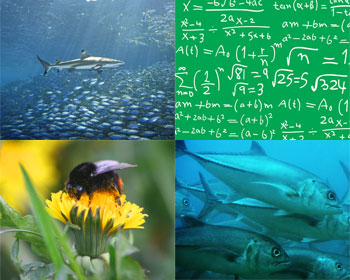A Publication of the
Applied Math and Science Education Repository

The AMSER Science Reader Monthly aims to provide educators with a useful package of information about a particular topic related to applied math and science by combining freely available articles from popular journals with curriculum, learning objects, and web sites from the AMSER portal. The AMSER Science Reader Monthly is free to use in the classroom and educators are encouraged to contact AMSER with suggestions for upcoming issues or comments and concerns at [email protected].
This month's AMSER Science Reader Monthly topic is Sustainable Agriculture.
Sharks Use Math To Hunt
Article
by Alexandra Witze
Synopsis and resource annotations by Max Grinnell

How do sharks hunt for and find their prey? Marine scientists and others have developed many theories on how this process works, and the question continues to receive a large amount of attention. This compelling article by Alexandra Witze from the July 3rd, 2010 edition of Science News examines new research on how sharks might use mathematical strategies to find their next meal.
The piece begins by discussing a new study that appeared in June 2010 in the magazine Nature. The study noted that sharks and other marine predators could be following "strict mathematical strategies" while making their way through the ocean. The suggested pattern that they follow is known as a Lévy walk. This unusual "walk" involves animals taking long forays in a particular direction and these forays have a distinct resemblance to different types of fractals when taken as a whole.
Most biologists once believed that animal foraging was dominated by random motion, however in 1996 a team of researchers observed that albatrosses made an occasional long flight that seemed distinctly like the Lévy walk. After this observation, biologists began to notice other animals engaging in the Lévy walk, including deer and bumblebees. After sometime, the original study from 1996 came under attack in the scientific community, and it was debunked as inherently flawed.
This new study by David Sims, a researcher at the Marine Biological Association of the United Kingdom in Plymouth, states that he and his colleagues have found the Lévy patterns and behaviors in at least 14 species, including marlin, tuna, and sharks. Currently, Sims and his colleagues are seeking additional evidence of Lévy behavior in lower marine animals such as octopuses. It remains interesting work, and it will be exciting to see how it advances in the coming years.
Found below is a list of useful resources that will illuminate and enhance understanding of the topics found within this article. The first link will take users to an informational website created by the Monterey Bay Aquarium. Focused on the world of the shark, the site includes instructional resources, videos, and information on different species of shark. The second link will take users to the Center for Ocean Sciences Education Excellence site, which provides a plethora of information on marine life. The third link whisks users away to a fascinating site created by Paul Bourke of the University of Western Australia, which presents some basic information on fractals. The fourth link leads interested parties to a very fun and interesting Flash-based fractal maker, courtesy of Daniel Gries and the Mathematical Association of America. Moving on, the fifth link leads to the Animal Diversity website, which features a database of species organized by common or scientific name. Each entry features additional information, including natural history, habitat details, and photographs. Finally, the last link leads to a beautiful website from National Geographic which explores the complex world on animal migrations, with a focus on army ants, an African elephants, the red crab, and of course, sharks.



